It’s a lovely Sunday afternoon. Across Maui, residents and visitors are enjoying a bounty of outdoor activities. Well, except me. Political junkie that I am, I am surrounded in my office with printouts of Maui precinct counts: highlighting results, giving my calculator a workout, and otherwise searching for meaning in this most recent election.
I have not been alone in this endeavor, which is a good thing. I’ve only watched four elections since moving here (two of them seriously) and have little institutional knowledge to bring to the table. For that, I turned to frequent debate moderator and political analyst Dick Mayer and veteran journalist Susan Halas, whose Maui election-watching dates back to the 70s. They graciously provided analysis, insight, and suggestions for result organization as I waded through pages of data.
The Results
This month’s election saw voters elect progressive-minded candidates to the Maui County Council and approve six of seven charter amendments. That’s despite attempts by so-called “dark money” groups to get an opposite result. The donor-opaque, mainland-created Hui O Maui spent $297,500 to support a slate of conservative candidates and to urge rejection of all the charter amendments. The National Association of Realtors Fund disbursed $60,000 to support Stacy Crivello. They easily outspent progressive organizations who advocated the opposite.
The re-election of incumbents Tamara Paltin, Kelly King, Keani Rawlins-Fernandez and Shane Sinenci, and the addition of new Lanai Council Member Gabe Johnson, gives progressives a solid majority on the nine-member Council. With an additional vote from Council Member Mike Molina, the progressive majority could also override any mayoral veto.
The failure of the Office of Managing Director came as a surprise to many, although it has failed with voters before. The bigger surprise was the overwhelming support for the creation of a Maui Department of Agriculture. The charter amendment results, in particular, showed that Maui County voters made up their own minds about the charter amendments, rather than being swayed by “Vote No” or “Vote Yes” efforts about the entire slate.
Now, let’s start crunching:
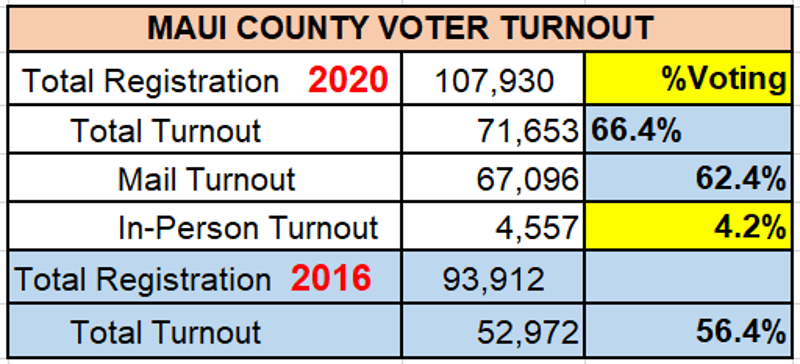
Comment: Traditionally, Hawaii has had some of the lowest voter turnout rates in the country. Not this year. Whether it was the advent of mail-in voting, the potency of the presidential race or the Maui election itself, 14,018 new Maui County voters registered in 2020. Then, 18,661 more of us actually voted in 2020, an increase of ten percentage points over 2016.
###
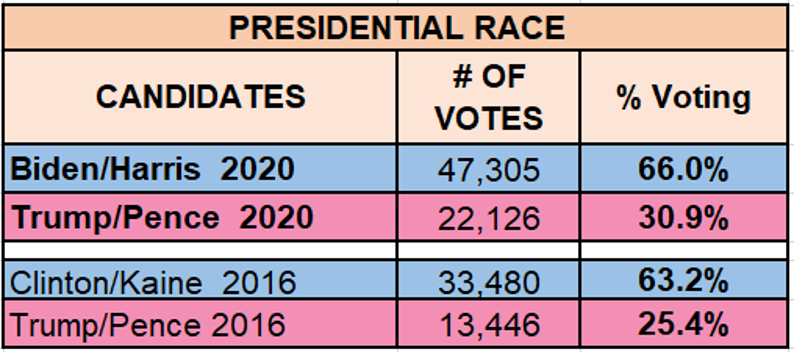
Comment: On Maui’s very Blue islands, the number of Republican votes increased by significant numbers in 2020. In 2016, a year where it was unclear whether a vote for Donald Trump was actually a vote for him or a vote against Hillary Clinton, the Trump/Pence ticket received 13,446 votes in Maui County. That number jumped this year by 8,665 votes, to 30.9% of total votes cast. Also following the national trend in 2020 was an increase of 13,825 Democrats casting votes.
It’s worth watching to see what happens to these Republican voter numbers in coming years. As Susan Halas put it, “Whether [the increase] is due to Trump or due to dissatisfaction with the ossified Democratic majority is not clear. Could be both.”
The other interesting note is not to be found in the chart above. This year, Maui County residents could vote by mail or deposit ballots at drop off boxes. Or, they could vote in-person at walk-in centers around the islands. Although Biden/Harris won all 35 Maui County precincts, residents who chose to vote in person—and it was only a tiny number– overwhelmingly supported the Trump/Pence ticket. That would coincide with President Trump’s insistence that in-person voting was the only “safe” way to vote.
Only two precincts diverged from this Trump/Pence pattern. A majority of in-person voters in Hana went for Biden/Harris, 10-6. Molokai’s Kilohana Center reported a walk-in tie: 9 votes for Trump/Pence; 9 for Biden/Harris.
There seemed to be little confusion about who to choose. Unlike the high number of blank votes recorded in other races (see below), only 555 voters left their presidential choice empty, just 0.8% of all ballots cast.
###
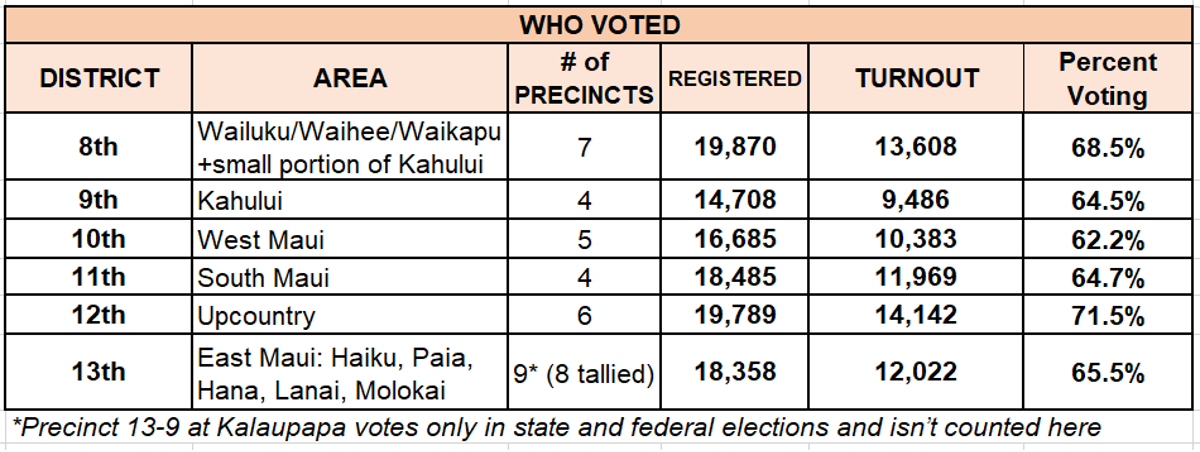
Comment: Upcountry voters turned out in greater numbers than any of the other districts, followed by the 8th District, then eastern Maui and the “canoe district” of Molokai and Lanai.
###
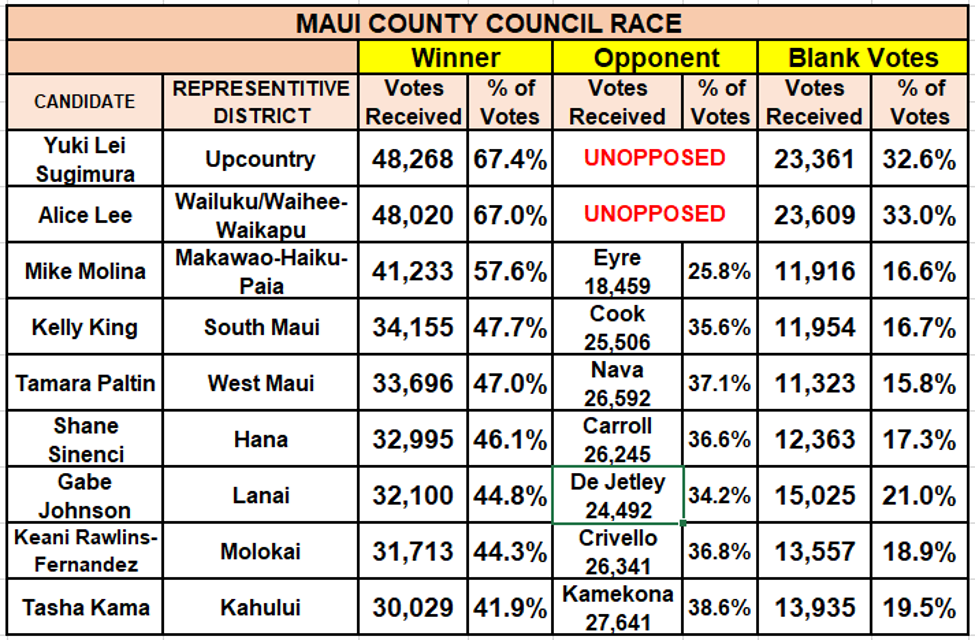
Comment: Maui County voters may vote for all nine candidates, regardless of where they live. Taking away the unopposed runs of Yuki Lei Sugimura and Alice Lee, Council Member Mike Molina was the top vote-getter in the Council races. It puts him in good position to challenge Michael Victorino for mayor if Molina chooses that path in 2022. Kelly King, another frequently mentioned potential mayoral candidate, also made a good showing. The Kama-Kamekona race was the tightest, with Kama winning by 2,388 votes.
Votes for Council Members in their own representative districts varied widely. Keani Rawlins-Fernandez lost on Molokai by 339 votes; Gabe Johnson lost on Lanai by 87—not an unusual occurrence, according to Mayer and Halas. At the other end of the spectrum, Shane Sinenci took 72% of the votes in his home district of Hana. The remaining candidates won their representative districts by percentages ranging from 50%-55%.
It will be interesting to see whether Stacy Crivello, Claire Kamalu Carroll and Rick Nava plan to run for the same seats in the future, after losing in 2018 and 2020 to, respectively, Rawlins-Fernandez, Sinenci and Paltin.
###
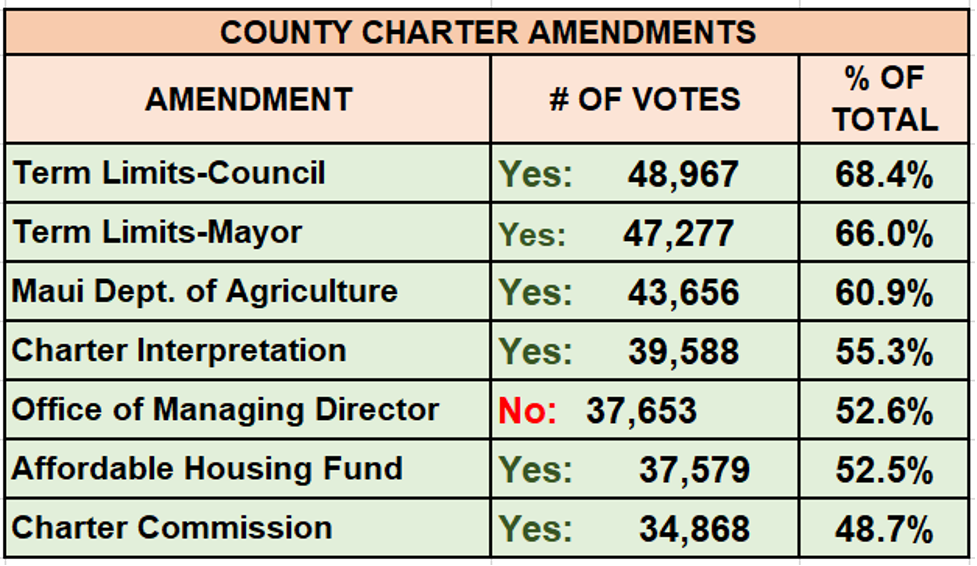
Comment: The biggest charter amendment surprise was the unanimous precinct support for the creation of a Maui Department of Agriculture. Support was strong whether voters were pro-Biden or pro-Trump, the latter surprising because those voters tend to vote against issues that cost money. The measure failed only among in-person voters in Spreckelsville, 6-14. It tied among in-person voters in the Pukalani Elementary School precinct (53-53) and at the Maui Economic Opportunity precinct in Wailuku (30-30).
Do voters think elected officials stay in office too long? The answer appears to be a resounding yes, considering the overwhelming votes cast in that direction. Every single precinct voted in favor of those two charter amendment issues. The only exception: the in-person votes from Molokai’s Kilohana Center precinct which voted against both (9-10 against council term limits and 8-10 against mayor’s term limits).
The Office of Managing Director charter amendment failed to find support in 33 of the 34 precincts. It passed in Haiku by 518 votes, 2,687 to 2,169.
###
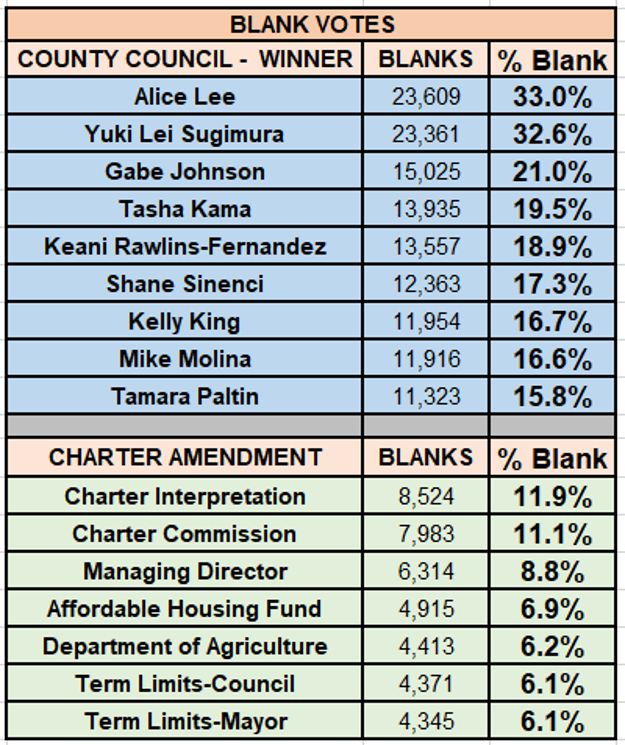
Comment: Interpreting blank votes always involves a lot of qualifications, especially when it comes to County Council candidates. Did people leave blanks because they didn’t know that they could vote for all nine candidates? Because they didn’t know anything about the candidates? Or did they leave a blank as a protest vote against a particular candidate? No one knows, but as the table above indicates, a lot more voters were unsure about County Council candidates than they were about the charter amendments. Not surprisingly, amendments relating to the charter commission and charter interpretation produced the most blank votes. For the average voter, they were hard to interpret and understand. Everybody seemed to understand term limits on the council and the mayor; however, not as much as they understood whom they wanted as president. As mentioned earlier, the number of blank votes for president was .8%.
The Takeaway
So, the voters have spoken. Now what? The challenges for post-election Maui County are considerable. At the top of the list is the newly-approved creation of a Department of Agriculture, which may be easier to okay than to implement, especially in the pandemic-induced financial austerity the County currently faces. Add to that squabbling agricultural factions and potential mayor-council conflicts, and progress could be bumpy.
Voters also approved new funding for affordable housing, which will require council attention on how to properly allocate those monies.
The new, progressive-majority council will soon be engaged in normal post-election activities like re-jiggering committees and appointing a Council Chair (or keeping current Chair Alice Lee in place, as has been widely speculated). Although it may have new term limits imposed on it, the Council has become considerably more powerful with voter approval of the charter interpretation amendment, which will permit it to seek outside counsel for disputes with the mayor (such as the Lahaina injection wells lawsuit, which the council wants to settle and the mayor does not). Plus, voters passed the amendment allowing the council to appoint 9 of the 11 members to the Charter Commission. Previously the mayor appointed all 11. When established, that commission will probably take up the voter-defeated County Manager issue, much to the delight of the progressive groups that supported it.
Mayor Michael Victorino needs to confront a new political environment where he no longer reigns supreme. Even though the Office of County Manager charter amendment was defeated—despite lots of effort on his part—his office has been weakened by the charter amendments that did pass. He has new term limits, the aforementioned charter commission revisions, and he has a council whose majority differs from him philosophically.
The next two years will make for some interesting politics.



Pingback: CRUNCHING THE NUMBERS: Presidential/Council/Charter Amendment Results from Maui County’s 2020 General Election - Maui Pono Network